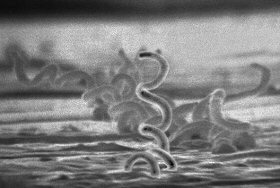 In 1492 Columbus sailed the ocean blue.
In 1492 Columbus sailed the ocean blue.
In 1493 he brought back syphilis.
That's the theory anyway. Or at least it has been for the last couple of centuries.� But that theory is deeply controversial and until recently it has been based solely on circumstantial evidence.� Columbus returned from his first voyage in 1493. The symptoms we associate with syphilis were first reported in an outbreak in Naples in 1494. Within one hundred years one-quarter of Europe's population was afflicted with the disease.�
Besides the coincidental timing, the theory also has the satisfying sense of poetic justice. Europeans may have devastated the Americas with germs, guns and greed but fate had its own retribution in store. For all their piety and outspoken veneration for God and all he stood for, the Europeans hit the beach fucking, on both sides of the Atlantic, and they paid for it... big time.
Syphilis wasn't the first venereal disease Europeans suffered from. Gonorrhea, herpes and chlamydia had all been making the rounds since before recorded history began. But none of these diseases had the devastating effect that syphilis did when it hit Europe for the first time.
The reason we know exactly when the first outbreak occurred is because no one had seen anything like it before. The name "syphilis" was coined by the Italian physician Girolamo Fracastoro in 1530 but it had gone by many names before that. The Italians and Germans called it the French disease. The Dutch called it the Spanish disease. The Russians called it the Polish disease. It wasn't just that they wanted to blame their enemies. The disease was so new and devastating that it seemed, quiet rightly, that it had been brought nefariously from somewhere else.
 The disease is caused by an infection of the spirochete bacterium Treponema pallidum, a spiral shaped microbe that transports itself into and through the mucus tissues of the recipient like a corkscrew. It manifests itself in three stages.
The disease is caused by an infection of the spirochete bacterium Treponema pallidum, a spiral shaped microbe that transports itself into and through the mucus tissues of the recipient like a corkscrew. It manifests itself in three stages.
In stage one it appears as a chancre at the point of contact, usually in the genital region, lasting a few weeks. Stage two follows a couple of months later and is manifested by a measles-like rash that covered large areas of the body. Stage three is less visible but more pernicious.� Tumor-like balls of inflammation, called granulomas, appear throughout the body including the skeleton and central nervous system.� Most deaths from syphilis occur in stage three. Frequently, the symptoms are accompanied by insanity and blindness.
 But when syphilis first appeared in Europe the symptoms were so severe that many people died in stage two. In his book Guns, Germs and Steel, Jared Diamond described it thus: "Its pustules often covered the body from the head to the knees, caused flesh to fall from people's faces, and led to death within a few months." But by the mid-16th century the disease was much less virulent. Nobody knows why. Either the bacterium evolved or we did. Or maybe it was a bit of both.
But when syphilis first appeared in Europe the symptoms were so severe that many people died in stage two. In his book Guns, Germs and Steel, Jared Diamond described it thus: "Its pustules often covered the body from the head to the knees, caused flesh to fall from people's faces, and led to death within a few months." But by the mid-16th century the disease was much less virulent. Nobody knows why. Either the bacterium evolved or we did. Or maybe it was a bit of both.
So why is the theory of an American origin so controversial? The evidence may be circumstantial but so is that of a smoking gun held over a bullet riddled corpse. In the disease wars of the late fifteenth century wars this was clearly a slam dunk for the Americas (to be followed by a total run up in the score by the Old World over the following century, but that's beside the point).
Most experts do believe the disease was an American export but a very vocal minority believe the syphilis epidemic of the late 15th century was a mutant form of a pre-existing Old World condition called yaws (also known as endemic syphilis). Yaws is caused by the T. pallidum bacterium too, but what distinguishes syphilis is that it is spread through sexual contact.
The "European origin" hypothesis, otherwise known as the Unitarian theory, holds that syphilis arose from a mutation of the yaws bacterium, allowing it to become much more virulent and easily transmitted through sexual contact. The timing of the Naples outbreak was simply a coincidence. Indeed, proponents of this theory contend that there have been numerous epidemics of treponematosis over the centuries.
The evidence for this comes from several hundred disinterred skeletons from various periods predating the Columbus expedition. As I mentioned earlier, the tertiary stage of syphilis often affects all parts of the body, leaving distinct lesions in the skeleton. In one famous study of 240 skeletons exhumed from a medieval friary in Hull, UK, these lesions were found in an astounding 60 percent of the skeletons.� Now, I know what you're thinking, weren't friars supposed to be celibate?� Well, yes, but so were Popes and we all know how much they got laid. But it's probably more likely that these friars were afflicted by a non-venereal form of treponematosis.
While there is little doubt that treponemal diseases (such as bejel) existed in the Americas prior to the Columbus expedition, there is no direct evidence that they were transmitted sexually.� Certainly the virulent form of the syphilis that afflicted the Europeans does not seem to have similarly affected the denizens of New World as severely.
Most experts think that the syphilis bacterium as we currently know it probably did exist in the Americas before the Columbus expedition. It may have even been transmitted sexually. But over the centuries, susceptibility to the diseases had been bred out of the indigenous populations much as susceptibility to small pox had been bred out of the Europeans. When the Spanish sailors disembarked their bodies were walking Petri dishes for T. pallidum, as were their sexual partners back home.
Ultimately the answer to the riddle of syphilis' origins will be found in the emerging science of molecular genetics. The genome of T. pallidum was sequenced in 1998 and while there appears to be very little variation between the various subspecies of the bacterium, there is enough that it should be possible to determine if the subspecies that causes syphilis comes from the New World or is a mutation of Old World yaws.�
In fact, a study into this possibility was published in January 2008 by geneticists from Emory University in Georgia. Their conclusion: Yaws is the oldest form of the treponema bacterium. Syphilis arose more recently and is indeed more closely related to the American variant. So is this the last word? Not quite. Only a small portion of the genomes were compared, so the jury is still out.
Related:
Back To The Future For Syphilis Research
When Circumcision Was The Cure For Everything
Getting Laid In The Middle Ages
Holidays Abroad Lead To Risky Sex And STDs

